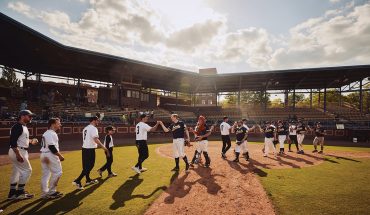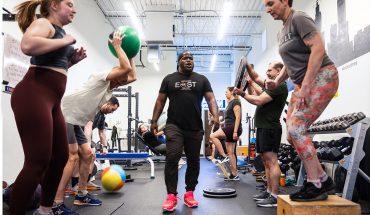by Ann Brooke Raynal
photographs by Carla Williams
Seventeen girls dot the gravel track at Underwood Elementary, cheeks flushed and lungs full. Most are running. Some have slowed to a trot, and a few are walking, but they’re all smiling. No one is counting laps, and each girl is moving at her own pace.
Earlier, the group sat in a patch of sunshine with three female coaches, and talked frankly about positive self-image, or what their coaches call “plugging in to a positive cord.”
These girls are among the hundreds of 9- to 12-year-old Wake County girls who participate in an innovative program called Girls On The Run. Founded by Charlotte runner Molly Barker in 1996, the nonprofit organization aims to give pre-adolescent girls the tools they need to become strong individuals through running and honest conversation.
“The best thing about Girls on the Run is that you get to know everybody really well, even the fifth graders,” says returning third grader Janie Hill. “ ‘Positive cords’ are being happy and cheerful and setting a good example. Thinking badly about yourself and others – those are ‘negative cords,’ ” she says. “And the running is fun, too!”
It’s all part of a carefully considered curriculum. “Girls get trapped in a ‘girl-box,’ ” says Juliellen Simpson-Vos, executive director of the organization’s Triangle chapter. “They’re torn between who they know they are, and what our culture says they should be.”
Parents and educators know that the “girl-box” is being imposed at an increasingly early age, and GOTR seeks to reverse that trend. “Third through fifth grade is our target audience because girls at this age are most receptive to this message,” Simpson-Vos says. “And one of the most powerful tools in their toolbox is knowing that there are other girls who feel the same way.”
Eighteen years ago, the pilot program consisted of 13 Charlotte girls. This spring more than 130,000 girls in the United States and Canada are participating. Wake County is one of the fastest growing markets, with 57 sites. And though new locations are being added each semester, many sites still have waiting lists.
 Cameron Baird, an eigth grader at Ligon Middle School, is a GOTR alum. “I liked the way GOTR incorporated lessons with the running. One time we had a lesson on gossiping. And we formed a running line, kind of like the game ‘telephone.’ As one girl ran to another with the message, you could see how easy it is for rumors to spread. We understood how important it is to be sincere.”
Cameron Baird, an eigth grader at Ligon Middle School, is a GOTR alum. “I liked the way GOTR incorporated lessons with the running. One time we had a lesson on gossiping. And we formed a running line, kind of like the game ‘telephone.’ As one girl ran to another with the message, you could see how easy it is for rumors to spread. We understood how important it is to be sincere.”
Hope Squires, a lifelong-runner and one of the current coaches at the Underwood site, first volunteered as a coach “to instill a love of running in the next generation,” but stayed on because of the other changes she is seeing in her runners. Even in the course of one 12-week period, “I can definitely see a positive effect on the girls, especially in the shyer girls. The program boosts their confidence. They learn it’s OK to speak up for yourself.”
Darby Oakley, a third-grade teacher at Underwood Elementary has coached GOTR for several seasons. “I see the positive impact the program has had on my students. I see it on the playground and in the classroom.” The experience with GOTR has subtly informed Oakes’ teaching and the way she interacts with students, she says.
“I wish I had had something like this when I was coming along,” says Jeanine Bandini, a first-time GOTR coach whose third-grade daughter, Anna, is part of her group. “I hope to gain skills for myself and see my child gain skills as well. I am hoping for an increased ability to communicate with her about pressures in our culture.”
Statistics reveal a dramatic drop in physical activity as girls approach the middle school years. Simpson-Vos says GOTR takes a holistic approach to solving the problem: “We know that physical activity helps girls with goal-setting and contributes to positive outcomes in so many areas of a girls’ life.” The group emphasizes individual accomplishment in whatever form that takes.
On April 12, these girls will participate in a 5k with their adult running buddies. Some girls will run it. Some will walk it. Either way, success is measured by challenges confronted. “Girls on the Run focuses on the girl as a whole,” says Oakley. They learn about endurance, and they can easily translate those lessons to other aspects of their lives. One of the questions we ask the girls after practice is, ‘Did you do anything that surprised you?’”
A curious phenomenon occurs when learning takes place in conjunction with physical movement: that new information sticks. As a former therapist and social worker, Bandini understands the science of kinesthetic learning. “GOTR lessons have them running and repeating positive self-talk at the same time. It’s doubly effective.”
Another activity has the girls writing down some of the negative messages they hear in their own heads. They sprint to the “Negative Nelly” box and deposit their examples of negative self-talk. Instead of becoming trapped in the “girl box,” these girls are shutting the box on anything holding them back. And throwing away the key.





